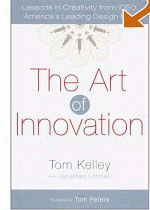Аннотация издательства
IDEO, the world's leading design firm, is the brain trust that's behind some of the more brilliant innovations of the past 20 years--from the Apple mouse, the Polaroid i-Zone instant camera, and the Palm V to the "fat" toothbrush for kids and a self-sealing water bottle for dirt bikers. Not surprisingly, companies all over the world have long wondered what they could learn from IDEO, to come up with better ideas for their own products, services, and operations. In this terrific book from IDEO general manager Tom Kelley (brother of founder David Kelley), IDEO finally delivers--but thankfully not in the step-by-step, flow-chart-filled "process speak" of most how-you-can-do-what-we-do business books. Sure, there are some good bulleted lists to be found here--such as the secrets of successful brainstorming, the qualities of "hot teams," and, toward the end, 10 key ingredients for "How to Create Great Products and Services," including "One Click Is Better Than Two" (the simpler, the better) and "Goof Proof" (no bugs).
But The Art of Innovation really teaches indirectly (not to mention enlightens and entertains) by telling great stories--mainly, of how the best ideas for creating or improving products or processes come not from laboriously organized focus groups, but from keen observations of how regular people work and play on a daily basis. On nearly every page, we learn the backstories of some now-well-established consumer goods, from recent inventions like the Palm Pilot and the in-car beverage holder to things we nearly take for granted--like Ivory soap (created when a P&G worker went to lunch without turning off his soap mixer, and returned to discover his batch overwhipped into 99.44 percent buoyancy) and Kleenex, which transcended its original purpose as a cosmetics remover when people started using the soft paper to wipe and blow their noses. Best of all, Kelley opens wide the doors to IDEO's vibrant, sometimes wacky office environment, and takes us on a vivid tour of how staffers tackle a design challenge: they start not with their ideas of what a new product should offer, but with the existing gaps of need, convenience, and pleasure with which people live on a daily basis, and that IDEO should fill. (Hence, a one-piece children's fishing rod that spares fathers the embarrassment of not knowing how to teach their kids to fish, or Crest toothpaste tubes that don't "gunk up" at the mouth.)
Granted, some of their ideas--like the crucial process of "prototyping," or incorporating dummy drafts of the actual product into the planning, to work out bugs as you go--lend themselves more easily to the making of actual things than to the more common organizational challenge of streamlining services or operations. But, if this big book of bright ideas doesn't get you thinking of how to build a better mousetrap for everything from your whole business process to your personal filing system, you probably deserve to be stuck with the mousetrap you already have.
|


